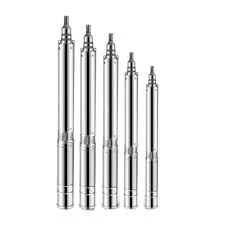Nov . 04, 2024 11:05 Back to list
Steps to Safely Remove a Submersible Well Pump from its Installation
How to Pull Out a Submersible Well Pump A Step-by-Step Guide
Submersible well pumps are essential for drawing water from deep underground sources. However, there may come a time when you need to pull out the pump for maintenance, repair, or replacement. This task can seem daunting, but with the right tools and techniques, you can successfully remove your submersible well pump with relative ease. Here’s a detailed step-by-step guide to help you through the process.
Safety First
Before you begin any work, safety should be your top priority. Turn off the power supply to the pump to prevent any electrical hazards. If there is water in the well, ensure you are equipped with proper safety gear, such as gloves and goggles. It’s also advisable to have assistance or let someone know what you’re doing in case of an emergency.
Tools and Equipment Needed
To pull out a submersible well pump, you will need the following tools
1. A pipe wrench or adjustable wrench 2. A cable puller or winch (optional but recommended for heavier pumps) 3. A set of pliers 4. Teflon tape or pipe sealant (for reassembly) 5. A sturdy container or platform to place the pump after removal 6. Safety gloves and goggles
Step 1 Disconnect Power and Unfasten Cables
Start by disconnecting the power to the pump completely. Locate the control box or circuit breaker and ensure that the pump is no longer receiving power. Next, carefully unclip and detach any cables from the pump. Take note of their positions, as you will need to reconnect them when installing a new pump or reassembling the existing one.
Step 2 Remove the Pump from the Well
Most submersible pumps are connected to a drop pipe via a thread or coupling. Using a pipe wrench, unscrew the drop pipe or unfasten the coupling. If your pump is heavy or deep underwater, a cable puller or winch can be beneficial here. Gently pull the pump out while ensuring that you do not damage the drop pipe or electrical lines connected to it.
how to pull out a submersible well pump

Step 3 Check for Debris and Damage
Once the pump is out, inspect it for any signs of wear, corrosion, or damage. Check the impeller and other components for blockages or breakdown. If your pump is not functioning correctly, identifying issues at this stage can save you time and effort.
Step 4 Clean the Pump and Components
Before you either repair or replace the pump, take the time to clean it thoroughly. Remove any debris, sediment, or buildup from the pump’s exterior. This will help maintain efficiency and extend the life of your pump.
Step 5 Reinstallation or Replacement
If you are reinstalling your current pump, make sure to follow all manufacturer guidelines for reassembly. Apply Teflon tape or pipe sealant where necessary to ensure a watertight seal. Carefully lower the pump back into the well, making sure to reconnect all cables and secure any couplings. If replacing the pump, follow the same protocol, ensuring compatibility with your existing system.
Step 6 Testing the System
Once everything is reassembled, restore the power supply to the pump and conduct a test run. Monitor for any unusual noises or leaks and ensure that the water flow is consistent.
Conclusion
Pulling out a submersible well pump may seem challenging, but with careful planning and the right tools, you can accomplish it safely and efficiently. Whether you are performing maintenance or replacing an old pump, following these steps will help ensure that you navigate the process smoothly. Always consult your pump’s manual for specific instructions, as procedures can vary based on the brand and model of the pump.
-
Submersible Water Pump: The Efficient 'Power Pioneer' of the Underwater World
NewsJul.01,2025
-
Submersible Pond Pump: The Hidden Guardian of Water Landscape Ecology
NewsJul.01,2025
-
Stainless Well Pump: A Reliable and Durable Pumping Main Force
NewsJul.01,2025
-
Stainless Steel Submersible Pump: An Efficient and Versatile Tool for Underwater Operations
NewsJul.01,2025
-
Deep Well Submersible Pump: An Efficient 'Sucker' of Groundwater Sources
NewsJul.01,2025
-
Deep Water Well Pump: An Efficient 'Sucker' of Groundwater Sources
NewsJul.01,2025
-
 Submersible Water Pump: The Efficient 'Power Pioneer' of the Underwater WorldIn the field of hydraulic equipment, the Submersible Water Pump has become the core equipment for underwater operations and water resource transportation due to its unique design and excellent performance.Detail
Submersible Water Pump: The Efficient 'Power Pioneer' of the Underwater WorldIn the field of hydraulic equipment, the Submersible Water Pump has become the core equipment for underwater operations and water resource transportation due to its unique design and excellent performance.Detail -
 Submersible Pond Pump: The Hidden Guardian of Water Landscape EcologyIn courtyard landscapes, ecological ponds, and even small-scale water conservancy projects, there is a silent yet indispensable equipment - the Submersible Pond Pump.Detail
Submersible Pond Pump: The Hidden Guardian of Water Landscape EcologyIn courtyard landscapes, ecological ponds, and even small-scale water conservancy projects, there is a silent yet indispensable equipment - the Submersible Pond Pump.Detail -
 Stainless Well Pump: A Reliable and Durable Pumping Main ForceIn the field of water resource transportation, Stainless Well Pump has become the core equipment for various pumping scenarios with its excellent performance and reliable quality.Detail
Stainless Well Pump: A Reliable and Durable Pumping Main ForceIn the field of water resource transportation, Stainless Well Pump has become the core equipment for various pumping scenarios with its excellent performance and reliable quality.Detail
